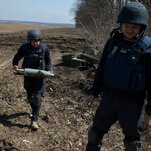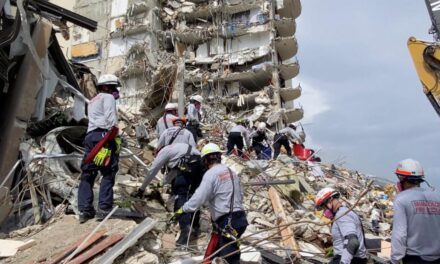
Civilians Near Kharkiv Are Discovering Timed Land Mines

Civilians near Kharkiv in northeastern Ukraine are discovering a new threat: munitions that eject up to two dozen small mines that explode at intervals.



BEZRUKY, Ukraine — When Sergiy, a 47-year-old construction worker, got out of bed Sunday morning in this small town in northeastern Ukraine, he discovered a chilling new hazard in a war filled with them: He had woken up in a minefield.
He had heard a rocket land near his home around 1 in the morning but thought little of it. There had been plenty of rockets since Russian forces invaded in late February. The thuds, crumps and blasts had become a cruel but familiar soundtrack to those who stayed behind, along with the acidic smell the weapons left in the air.
But what landed in his yard was a new weapon for the town’s residents to add to their growing lexicon of destruction: they knew the Smerch, the Grad, the Hurricane — and now they were introduced to the PTM-1S land mine, a type of scatterable munition.
“Nobody understood what it was,” said Sergiy, declining to provide his surname out of fear of retribution. The weapons roar in like any rocket, but instead of exploding instantly, they eject up to two dozen mines that explode at intervals, parceling out death in the hours afterward.
Since the start of the invasion, Russia has made clear that it is willing to mete out violence and destruction to achieve its aims, often indiscriminately. It has launched cruise missiles, sent in tanks and fired mortars, artillery and rockets. Now it has also turned to something less ominous in appearance, but just as brutal.
These scatterable mines, banned under some interpretations of international law and never officially recorded during this war, have appeared only sparingly in Bezruky and elsewhere in the periphery of Kharkiv, Ukraine’s second-largest city. The weapons add yet another element of peril for civilians trying to navigate parts of the ruined landscape.
The mines are green tubes about the size of a liter of soda, packed with three pounds of explosives. They are often used to disable tanks but had, in Sergiy’s case, landed where his 8-year-old daughter likes to play when the weather is pleasant.
Image
“These weapons combine the worst possible attributes of cluster munitions and land mines,” said Brian Castner, a senior arms researcher for Amnesty International. “Any one of these indiscriminate attacks is unlawful, and they’re happening on top of each other.”
Scatterable land mines can include those meant to kill people and those designed to destroy tanks. The United States last used them during Operation Desert Storm in 1991, and they have since largely been banned by a 1997 international treaty signed by 164 nations, including Ukraine, that targeted anti-personnel mines.
Some anti-vehicle mines — like the PTM-1S that landed in Sergiy’s yard — have sensitive fuses that can cause them to explode when people pick them up, and can be considered anti-personnel mines. They are thus banned under international law, though neither Russia nor the United States has joined the relevant treaty.
The morning of April 3 began like any other in Bezruky since the Russian invasion began: another day without power for the several thousand residents, and the sporadic shelling between Ukrainian and Russian forces that had become commonplace.
It was mostly quiet, but at around 10 a.m., Sergiy’s backyard shed exploded. There was no sound of an incoming artillery shell or rocket, just the blast.
Sergiy, who had lived in Bezruky for much of his life, went out to inspect the damage. Debris had scattered all over his workbench, the side of the shed was damaged and a rectangular crater several inches deep had appeared.
He went out to board up the windows of his house, fearing there might be another explosion, when he spotted a green tube, another PTM-1S mine, next to the fence in his neighbor’s backyard. He quickly snapped a picture and went back inside.
It exploded 20 minutes later, he said.
“The bursts continued throughout the day with intervals around 50 minutes, and the last one was around 3 o’clock the next night after it first landed,” Sergiy said. There is no Ukrainian military equipment in Bezruky. The Russian front lines are roughly seven miles to the north, and to the south are Ukrainian artillery positions.
Image
The mines were set to self-destruct at specific times, a feature baked into each mine, which can be set at two-hour intervals for up to 24 hours. Nobody was killed or injured in the series of blasts that rocked his neighborhood.
“It was lucky that kids didn’t play there that day,” Sergiy said. “Normally they would play in the backyard at the time of the first pieces detonating, but it was rainy that day.”
Russia-Ukraine War: Key Developments
Card 1 of 4
Missile attack. A missile strike at a crowded train station in eastern Ukraine killed at least 50 and wounded nearly 100, according to Ukrainian officials, who blamed Russia for hitting a major evacuation point for those trying to flee before an expected stepped-up offensive.
Bomb disposal technicians in Kharkiv, who respond to calls for unexploded munitions across the city and its periphery, said this was the first recorded appearance of the PTM-1S since the war’s beginning.
As Russia shifts its focus to the country’s east after its stinging defeats around the country’s capital, Russian forces have increased their shelling around Kharkiv and elsewhere in the region, often resorting to indiscriminate attacks to tie up resources.
Intentionally targeting civilians with weapons of any kind is prohibited under the Geneva Conventions, and Russia’s use of these scatterable mines would likely constitute an indiscriminate attack, given that the artillery rockets carrying these mines, which can travel up to 20 miles, were fired at a civilian area devoid of military targets.
Image
“Last week this weapon appeared,” said the team leader of an explosives removal unit working in Kharkiv and the towns nearby. He provided only his first name, Maksym, for security reasons. There are at least six other teams like his deployed throughout the region.
The randomly exploding mines are just a new feature of Maksym’s grueling job. His team of half-a-dozen men have been working nonstop in the Kharkiv region since Russia invaded. It will likely take years, and possibly decades, to clear all of the ordnance launched into Ukraine during the war.
The 26-year-old team leader records five to 30 incidents a day, fields reports of rockets landing in homes on his phone and is often asked by passers-by to come look at explosive debris.
On Tuesday, Maksym’s rounds included digging out a 122-millimeter rocket casing from in front of a supermarket and removing debris from an apartment building and an amusement park.
Toward the end of the day, as he worked in a farmer’s field to extract the remains of a Smerch rocket, a man on a bicycle rode up and waved him down.
“Can you go pull out the same thing from my place?” the man shouted.
Thomas Gibbons-Neff reported from Bezruky, and John Ismay from Washington. Natalia Yermak contributed reporting from Bezruky.
Source: https://www.nytimes.com/2022/04/08/world/europe/ukraine-russia-land-mines.html

















